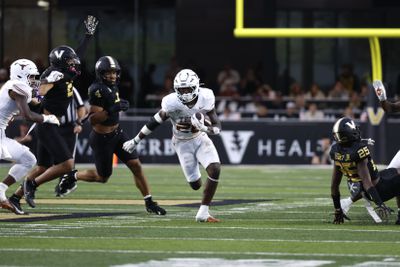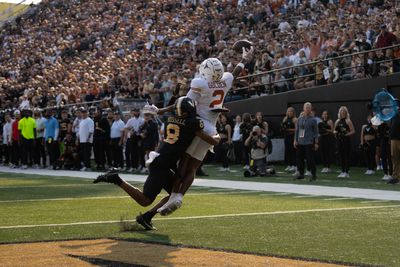
The Longhorns secured a victory, but how did they perform when it mattered?
In a gritty 27-24 win against the No. 25 Vanderbilt Commodores, the No. 5 Texas Longhorns bounced back behind a stellar performance from quarterback Quinn Ewers, who shook off two tipped interceptions to throw for 288 yards and three touchdowns while completing 73 percent of his passes, including a streak of 17 in a row in the first half.
While the offense and Ewers looked more in rhythm on Saturday than last week against Georgia, the showing was far from mistake-free football. The Longhorns turned the ball over twice, gave up four sacks, and had six offensive penalties.
So, did the good or bad show up in key areas of the game? In this week’s edition of Crunch Time, we’ll analyze how the Longhorns performed on third downs and in the red zone, two critical aspects of offensive success.
Third downs
9-of-15 (60.0 percent)

Photo by Matthew Maxey/Icon Sportswire via Getty Images
The Longhorns came out hot on third down, starting a perfect 4-for-4 in route to 14 first-quarter points. The key for Texas was winning first and second down in order to set up third and short. Throughout the year, this has been a key factor when the Longhorns have had success on third downs. On the four third-down conversions in the first quarter, the average distance to go was 3.25 yards with only one of the four attempts coming on 3rd and 3 or longer.
17 consecutive completions for Quinn Ewers after TD pass No. 3️⃣#Longhorns | #RatedProspect
— The Draft Network (@TheDraftNetwork) October 26, 2024
The Longhorns offense stayed ahead of the chains consequently setting up scenarios where Texas could run or pass on third down and giving head coach Steve Sarkisian a favorable hand from which to draw.
One early momentum-taking third-down conversion came when facing a 3rd and 8. The Texas defense had just forced a three out after the offense knotted the game at 7-7 and punt returner Silas Bolden had set up Texas with fantastic starting field position. The game was tied, but the Horns had clearly built some momentum and now had the ball.
After a 20-yard completion moved the ball to the Vanderbilt 29-yard line, the offense sputtered on first and second down, gaining only two yards. Facing 3rd and 8, the Longhorns needed an answer to keep the drive alive.
With the ball on the right hash, Sarkisian opted for a three-wide receiver set. Motioning from the short side of the field, DeAndre Moore Jr. came set at the left hash before taking off on a slot fade. After briefly glancing right, Ewers delivered to a streaking Moore for a touchdown.
@QuinnEwers @DeandreMooreJr pic.twitter.com/dDQPuGZ7Ai
— Texas Football (@TexasFootball) October 26, 2024
On the play, Vanderbilt displayed a Cover 2 Shell before moving into a Cover 1 Robber. Ewers took advantage of the free safety playing center field with the throw down the left side of the field, a smart decision that he created.
In the post game, Moore said,
“The first one, I was motioning over and Quinn changed the play mid-motion. He told me another play. So I’m like ‘Okay, bet. It’s man. Let’s go get it.’ He just called a slot fade, put it up there, and allowed me to go make a play.”
On Monday, Sarkisian revealed that the team practices Ewers signaling the route change to Moore, but in this instance, Ewers simply gave Moore a verbal direction as he went past.
“That’s a guy in year three in your system that is communicating with probably one of your smarter players on offense, too, in DeAndre Moore and them being in sync and being on the same page. I don’t think the other nine guys on the field had any idea that he changed the route for DeAndre on that play, so pretty high-level stuff with two guys that trust one another,” Sarkisian said.
For the rest of the game, the Texas third-down performance was a tale of two extremes. Thanks to penalties and poor execution on first or second down, the Longhorns offense faced a much greater distance to gain than the initial four attempts. This led to more negative-yardage plays when the Longhorns were stopped, but huge gains when Texas converted.
For example, Ewers was sacked three times in the remaining 11 third-down attempts. On those three third-down attempts, the average distance to get a first down was 8.0 yards, a non-trivial amount. What’s worse, one of those sacks came on a 3rd and 11 after a first-down rush on 3rd and 1 was called back thanks to holding.
One sack in particular highlights the difficulties of third and distance for an offense came with 14:00 left in the game and the score 24-17.
Facing 3rd and 11, Texas chipped with a running back against a four-man rush, but still gave up the sack. While this shouldn’t occur, the amount of time needed to complete a pass down the field makes it such that the lineman are at a disadvantage. In addition, opposing linemen can attack differently if they are confident that the Longhorns will be throwing the ball.
Sack 4: pic.twitter.com/jXUn5vD7Oe
— Captain Bruisin, cruise director (@Ian_A_Boyd) October 29, 2024
Shifting to the remaining conversions, the Longhorns offense moved the chains on third down five times. As mentioned, the conversions against Vanderbilt were chunks plays created by the large distance needed to move the sticks. Let’s break down the five conversions:
3rd and 5 or less: 0
Average distance to go: 9.4 yards
Average distance gained: 19.4 yards
Total yards gained: 97 yards
Plays with 20 yards or more: 4
20-yard rushes or longer: 2
Number of players to convert a first down: 5
The message is clear: Texas had some huge plays on third down where the only option was to push the ball.
Three notes: first, Texas needed a substantial amount of yardage on these third-down conversions; second, the Horns ran for 20 yards or more on third-down conversions multiple times, once each by Jaydon Blue and Quintrevion Wisner; third, three different receivers converted third downs in this subset of conversions, meaning five players were responsible for each of Texas’ five third-down conversions that occurred after the first quarter.
While this demonstrates the depth, explosiveness, and potential of the current Texas offense, the argument that these conversions shouldn’t be celebrated is credible — the Longhorns simply cannot expect to routinely convert third downs in this manner.
Furthermore, the offense did not consistently execute when Texas was required to gain sizable amounts of yards on third down. The Longhorns are fortunate to have been able to convert these low-odds chances, but it does not substitute a need to work to eliminate third and distance or even the frequency at which Texas faces this perilous scenario.
For the season, Texas has converted third downs at a rate of 46.5 percent, which remains an improvement from the 38.4 percent conversion last year. The Longhorns currently rank 19th in the country and fourth in the SEC in third-down conversion rate.
Red zone
3 attempts. 1 passing touchdown. 2 made field goals.

Photo by Caten Hyde/The University of Texas Athletics/University Images via Getty Images
Texas was able to secure 13 points on three red-zone trips thanks to a three-yard touchdown reception by wide receiver Matthew Golden and field goals of 23 and 40 yards by place kicker Bert Auburn.
Texas secured seven points on a statement drive that came in a critical moment early in the game. After Vanderbilt cashed in the tipped interception for a touchdown, the Longhorns offense responded with a nine-play, 75 -ard drive that included multiple third-down conversions, one of which came inside the red zone.
The red-zone trip itself began on the 15-yard line and featured three different players on four total plays, all of which were passes. It appears that Sarkisian rather clearly wanted to use numbers advantages in this area of the field, which Ewers delivered, whipping the ball out wide where Texas had enough perimeter blocking to secure a positive gain on multiple occasions.
In these scenarios, the glory of Sarkisian as a play designer work with the pre-snap smarts of Ewers to move the ball with little to no risk. Sarkisian draws up plays with wide receiver splits, pre-snap motion, and previous tendencies in mind such that he can stretch a defense into exposing their coverage before the snap. Ewers, whose robust mental capacity flies under the radar, is responsible for identifying these exposures and capitalizing on them by making the right read.
Many times, this manifests in short, quick throws to the perimeter where Texas can bite off a cheeky gain.
This four-play sequence started with Ewers checking down to Blue in the flat for a short gain. Second down demonstrates the ability of Ewers to identify advantages for Texas before the snap and execute. With the ball on the right hash, Ewers opted to fake the RPO hand off and quickly swing the ball to Moore where he had two lead blockers and the next closest defender was 10 yards away. Moore gained an easy six.
Facing 3rd and 1 at the six-yard line, Ewers made a similar pre-snap read. Sarkisian opted to use an extremely tight, three-wide receiver formation. Based on the alignment of the defensive backs and their stance, namely each of them crouched and staring directly at the Texas receiver, Ewers identified man coverage. He also knew that Moore was running a speed out from the slot. From this, Ewers deduced that Moore had to out beat one defender to the edge with the added advantage that the defender had to navigate a natural rub from Golden’s route.
This thought process by Ewers was still only half the battle. Not only could he be wrong, but he had to fake the hand off and deliver an accurate ball in a hurry, which then has to be caught with enough room for Moore to gain enough yards for a first down.
It wasn’t an issue for either of them. Ewers delivered. Moore secured the catch and the necessary yards. First down, Texas.
On 1st and goal from the 3-yard line, the thought process for Ewers was similar. Based on the alignment and personnel of the defense, Ewers was able to identify man coverage against Golden and Ryan Wingo on the far side of the field.
Once again, the slot receiver, this time Golden, is instructed to run an out while the outside receiver runs a slant. Golden has to run away from his defender with the added help of the rub from the slant.
While this appears just as simple as the previous completion, the throw required for this play is extremely high level. Ewers catches the snap on the right hash mark while Golden’s route takes him all the way to the left sideline, a horizontal distance that is ripe for throwing errors that could not only result in not only an incompletion but an interception or even pick six.
Matthew Golden with a one handed TD.#CollegeFootball #HookEm pic.twitter.com/l5b7LDsIDk
— Pick 6 Pack (@Pick6PackFB) October 26, 2024
Ewers was able to loft the ball over the pursuing defender and into Golden’s vicinity with a touch that while not perfect is levels above the average college quarterback. Golden reciprocated this effort with a masterful one-handed catch, one of the best snags from a Texas pass catcher the entire season.
This red-zone drive demonstrates how Texas can take advantage of defensive vulnerabilities to move the ball, even in close quarters. The effortlessness of this sequence creates the appearance of ease and expectation of reoccurrence. Yet, as explained, these plays require heady understanding of all 22 players on the field and the ability to execute. Neither is enough alone.
Texas’ final red-zone drive, this one in crunch time, demonstrates how the offense can get thwarted in the final portion of the field. With the game still in the balance and a couple minutes left in the fourth quarter, Texas clung to a seven-point lead. With the ball at the Vandy 28, Blue ripped off a 23-yard gallop to move the ball to the 5-yard line, setting up 1st and goal.
Any points would put the game out of reach, but a touchdown would deliver the knockout blow while making a statement.
On first down from the left hash at the 5-yard line, Sarkisian faced a tough defensive look with limited play-calling options. Vanderbilt lined up in a five-man front with three downhill backers behind them — difficult to run against. Sarkisian tried to spread the defense by splitting three wide receivers, pulling three defenders from the box. However, with the remaining eight defenders keen on the run, this wasn’t enough.
In this exact scenario, everyone knew it was a running play and Vanderbilt still had two timeouts and the two-minute warning to use. The threat of a pass is non-existent and on a straight handoff to Blue, the play went for no gain.
A big part of what makes Sarkisian an offensive guru is his ability to stretch a defense. But being one-dimensional dulls that ability, as seen here.
However, Sarkisian knew that everyone was keened into the run and bet that Vandy would continue with Cover 0, the same red-zone look they’d been playing all game. Rather than calling another run play, Sarkisian gave Ewers the chance to land the knockout punch with an RPO call on second down. Ewers had the opportunity to put the ball in the air if he saw a defensive read that was favorable.
Sure enough, Vanderbilt lined up in the same formation and coverage. Ewers pulled the ball and look for Moore on a slot slant that had plenty of space, but not nearly enough separation for a completion. Incomplete.
On third down, Texas ran the ball for no gain before kicking a field goal.
This red-zone series demonstrates how various factors can weaken an offense. While Texas was mindful of running the clock, it’s clear here how a defense can create favorable scenarios against them. A red-zone trip, after all, comes down to both play calling and execution.
The Vanderbilt defense all but begged Texas to throw on any of these three plays. Yet, when the Longhorns tried to capitalize on second down, it still didn’t end well, despite the right play call and personnel. Sometimes, the defense makes a play, even when Texas seemingly has the advantage.
For the season, Texas has scored 29 touchdowns on 39 red-zone attempts in addition to five red-zone field goals made for an overall scoring rate of 87.2 percent, which is 55th in the country. At 74.4 percent, however, the touchdown rate for the Longhorns is 13th, up from 120th at 50.8 percent last year.